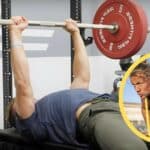Ever wondered what it takes to master the mighty pull-up? Or are you a seasoned athlete looking to knock 15+ pullups unbroken?
The answer is simple, just do more pull-ups and chin ups.
(Kidding. While this advice can certainly help, here’s a full-on game plan to get where you want to be, wherever you are right now.)
First, determine where you currently stand, and head to the appropriate section of this article:
- I’m a beginner looking to get his first pull-up
- I can get 3-7 pull-ups in, but I want more
- I can easily do 10-15, how do I get to 20+?
Jump to:
Section 1: For Beginners Starting Their Pull-Up Journey
You want to get a full pull-up with perfect form? This section is for you.
First, Build Foundational Strength
You need enough baseline strength to move the weight of your whole body. So for now, here are specific exercises that will help you develop the necessary muscle strength and control:
Scapular Pulls
This exercise helps in strengthening the muscles around your shoulder blades, which are crucial for pull-ups. Hang from the bar with straight arms, then pull your shoulder blades down and back, lifting your body slightly without bending your elbows.
Hold this position for a few seconds before releasing. It’s a small movement but very effective for building the right muscles.
Ring Rows
This exercise is fantastic for developing the back, arm, and core strength needed for pull-ups. To perform ring rows, you’ll need a set of gymnastics rings or a TRX suspension trainer.
Adjust the rings so they hang at about waist height. Grab the rings with your palms facing each other and lean back, extending your arms fully. Your body should be in a straight line from your head to your heels, and you’ll be at an angle to the ground. Pull your chest up to the rings while squeezing your shoulder blades together, then lower yourself back down with control.
The steeper the angle of your body (i.e., the closer your feet are to under the rings), the more challenging the exercise will be.
Inverted Rows
This exercise is great for building the back and arm strength required for pull-ups.
Set up a bar in a squat rack or use a Smith machine at waist height. Lie underneath the bar, grab it with a shoulder-width grip, and pull your chest up to the bar while keeping your body straight. Lower yourself back down with control.
Negatives Pull-ups
These are essential for beginners. Begin by standing on a step or box to reach the pull-up bar. Then, jump up to get your chin over the bar, starting in the top position of the pull-up. Slowly lower yourself down until your arms are fully extended.
The goal is to take about 3 to 5 seconds to lower yourself. This exercise focuses on the eccentric part of the pull-up, which is crucial for building the strength needed for the full movement.
Related: Best Pull Up Bars for Home
Assisted Pull-Ups
Using a resistance band or an assisted pull-up machine can be extremely beneficial.
Attach a resistance band to the pull-up bar and place your foot or knee in the band. This will help support some of your body weight as you perform the pull-up. The key is to use the least amount of assistance needed and gradually decrease it as you get stronger. This method allows you to practice the full range of motion of a pull-up while building up your strength.
Bonus: Planks

A fundamental exercise for core stabilization, planks are crucial for pull-ups. A strong core helps you maintain proper form and body alignment during a pull-up, reducing the risk of injury and improving efficiency. To perform a plank, start in a push-up position but rest on your forearms instead of your hands. Your body should form a straight line from your shoulders to your ankles. Engage your core, squeeze your glutes, and hold this position. Aim to maintain a neutral spine without letting your hips sag or pike up. Start with shorter durations, like 20-30 seconds, and gradually increase as your core strength improves.
Next, Develop Grip Strength

A strong grip ensures you can maintain a secure hold on the bar. Without adequate grip strength, your ability to pull yourself up is significantly compromised, no matter how strong your back and arm muscles are.
Here are simple exercises to improve your grip:
- Dead Hangs: This is as simple as it sounds. Just hang from the pull-up bar. It’s like being a kid on the monkey bars, but with a purpose. Start with short intervals and gradually increase your hang time. It’s a fantastic way to build endurance in your hands and forearms. Plus, it’s a great excuse to just hang around!
- Farmer’s Walk: Grab a pair of heavy dumbbells or kettlebells, stand up straight, and walk around. Keep your shoulders back and chest up. It’s like taking your muscles for a little stroll. Who knew grocery shopping could be a grip workout?
- Towel Pull-Ups: Wrap a towel over the pull-up bar and grab the ends. Now, do a pull-up. The towel adds an extra challenge to your grip. It’s like the bar got a slippery makeover.
- Plate Pinches: Take two weight plates and pinch them together with your fingers. Hold them for as long as you can. It’s like a game of ‘how long can you hold onto these dinner plates without dropping them?’ but with actual weight plates.
- Wrist Curls: Sit down, grab a dumbbell, and rest your forearm on your thigh with your palm facing up. Curl the weight towards your bicep, focusing on moving only your wrist. It’s a tiny movement with big results.
Then, Master the Technique
All right, so after a few weeks of working on your strength, you’re now ready to get your first pull-up in!
Here’s how:
Proper Form and Grip
First things first, let’s talk about your grip:
- Hands shoulder-width apart: This stance allows for a balanced distribution of effort across your back, shoulders, and arms
- Palms facing away: This is called an overhand grip.
- Straight arms to start: Begin with your arms fully extended and feet off the floor (No cheating with a little jump!)
Now, for the pull-up itself:
- Engage your core: This is crucial as it stabilizes your spine and provides a solid base, enhancing your pull-up performance and reducing the risk of injury.
- Pull with your elbows: Visualize pulling your elbows down to the floor. This will help recruit your back muscles.
- Chin over the bar: No need to go higher.
- Controlled descent: Lower yourself slowly until your arms are straight again.
Avoid Common Mistakes
We all make mistakes, but in pull-ups, some common ones can slow down your progress:
- The swinging body: Keep it still.
- Half-repping: No half-measures here. Full up, full down.
- Ignoring your back: Remember, your back muscles are doing the heavy lifting, not your arms.
Beginner routine to get that first pull-up
- Week 1-2: Grip and Hang Tough
- Day 1, 3, 5: 3 sets of 30-second dead hangs
- Day 2, 4: 3 sets of 10-second flexed arm hangs
- Week 3-4: Negative Pull-Ups
- Day 1, 3, 5: 3 sets of 5 negative pull-ups
- Day 2, 4: Rest or light grip exercises
- Week 5-6: Assisted Pull-Ups
- Day 1, 3, 5: 3 sets of 5 assisted pull-ups (band or machine)
- Day 2, 4: Core strengthening exercises
Section 2: For Intermediate Athletes Who Can Do 3-7 Pull-ups
Ok, so you can knock a few of these, but you now want to be able to do at least 10 unbroken reps?
Here’s how:
Focus on Full Range of Motion
Why Full ROM Matters: Ever seen someone at the gym doing those tiny, half-hearted pull-ups? Yeah, we’re not doing that. Full range of motion (ROM) means going from a complete hang to your chin over the bar. Why? Because it ensures you’re working all the muscles involved to their full potential.
Tips for Full ROM: Focus on your starting position for each pull-up with your arms fully extended. No cheating! Then, pull yourself up until your chin clears the bar. Feel every muscle engage and work. It’s tough, but oh-so-rewarding. Remember, quality over quantity!
Exploring Different Grip Variations
For intermediate athletes, varying grip styles in pull-ups is key to engaging different muscle groups, preventing overuse injuries, and overcoming training plateaus. These variations enhance overall functional strength, grip strength, and keep workouts challenging and interesting.
Try these variations:
- Wide Grip: This one’s a classic. It targets your lats more and is a bit tougher. Think of it as the big brother of the standard grip.
- Close Grip: Bring your hands closer together. This variation hits your biceps and the central part of your back. It’s like giving your muscles a surprise party.
- Mixed Grip: One palm facing you, the other facing away. It’s a bit quirky, but it challenges your muscles in new ways. Who doesn’t like a bit of a challenge?
Related: An In-depth Exploration of All Grip Types
Do Weighted Pull-Ups

Adding weight to your pull-ups is like hitting a turbo boost. Use a weighted vest, a belt with plates, or a backpack filled with books to ramp up the challenge.
Don’t go throwing a 50-pound plate on your first try. Start with something manageable, like 5-10 pounds. Once you can easily do 3-5 reps at that weight, gradually increase it.e top.
Increase Endurance
You’ve got the strength? Now let’s talk stamina. It’s time to boost your endurance to keep you hanging on (literally) for longer. Think of it as turning your pull-up session into a marathon, not a sprint.
Volume Training
- What’s Volume Training?: It’s all about increasing the number of reps and sets you do.
- Starting Off: Begin by adding just a few more reps to your sets, or throw in an extra set.
- The Magic of More: Gradually increase your volume over time. It’s not about going from zero to hero overnight.
Try Ladder Workouts
Imagine a ladder, each rung is a step up in reps. You start at the bottom with fewer reps and climb up to more reps, then back down.
How to Do It: Start with one pull-up, rest, then do two, rest, and so on. Once you reach your peak (say, five pull-ups), you climb back down. It’s like a rollercoaster for your muscles – up and down!
Why Ladders Rock: This method not only builds endurance but also keeps things interesting.
Intermediate Routine to get to 10 pullups
- Week 1-2: Refining Technique
- Day 1, 3, 5: 4 sets of 8 standard pull-ups
- Day 2, 4: 3 sets of 10 lat pulldowns
- Week 3-4: Strength Building
- Day 1, 3, 5: 4 sets of 5 weighted pull-ups
- Day 2, 4: Auxiliary exercises (rows, bicep curls)
- Week 5-6: Increasing Endurance
- Day 1, 3, 5: Volume training – 5 sets of 10 pull-ups
- Day 2, 4: Interval training with pull-ups and push-ups
Section 3: For Advanced Athletes Looking to Lock In 20+ Pullups
You’ve conquered the basics, you’ve built your strength, and now? It’s time to level up. Let’s dive into some advanced techniques to get to 20+ pulls.
Advanced Techniques
Lat Activation Techniques
- Mind-Muscle Connection: It’s not just about pulling yourself up; it’s about how you pull. Focus on engaging those lats. Imagine squeezing a pencil between your shoulder blades. That’s the kind of activation we’re talking about!
- Slow and Steady: Slow down your reps. Feel each muscle fiber firing up. It’s like telling your lats, “Hey, you’re up!”
- Pause at the Top: When you’re up there, chin over the bar, hold it for a second. Feel the burn? That’s your lats working overtime.
Advanced Grip Variations
- Mixed Grip Mastery: One palm facing you, the other facing away. It’s a game-changer. It challenges your muscles in new ways and keeps that progress coming.
- Towel Pull-Ups: Grab a towel, throw it over the bar, and pull up gripping the towel. It’s not just a grip strength monster; it’s a whole new level of pull-up prowess.
- The One-Arm Challenge: Ready for the ultimate test? The one-arm pull-up. Start with assisted one-arm variations and build up to the real deal. It’s tough, but hey, so are you.
Clap Pull-Ups
Clap pull-ups are an advanced, dynamic variation of traditional pull-ups that combine strength training and coordination.
Start by gripping the bar with hands slightly wider than shoulder-width, and pull yourself up forcefully to create enough momentum for a brief moment of weightlessness. At the peak of the movement, quickly release one hand to clap under the bar before grabbing it again, ensuring a swift and controlled motion.
For a more challenging version, try clapping with both hands. It’s crucial to have a controlled descent and to ensure you’ve built up enough foundational strength through regular pull-ups before attempting this. Always warm up thoroughly and consider using a spotter or assistance bands when starting out.
Enhanced Endurance Training
It’s not just about doing a few pull-ups; it’s about doing them again and again… and again.
Interval Pull-Up Workouts
- The Time Challenge: Set a timer. How many pull-ups can you do in 5 minutes? 10 minutes? It’s a race against the clock and a fantastic way to build both speed and endurance.
- Rest-Pause Method: Do as many pull-ups as you can, rest for a few seconds, then go again. This method allows you to do more reps in a single session by breaking them into smaller, more manageable sets.
- Tabata Style: 20 seconds of pull-ups, 10 seconds rest, and repeat. This high-intensity interval training (HIIT) approach will not only boost your endurance but also your overall fitness level.
Optimizing Body Composition
Let’s face it, each pound you lose will make it that much easier for you to lift yourself up. This alone deserves it’s full article (or program), but here are simple pointers to keep in mind:
Strategies for Fat Loss
- Calorie Counting, But Make It Fun: Yes, tracking calories can be a drag, but it’s a game-changer for fat loss. Think of it as a high-score challenge – can you hit your daily calorie goal?
- HIIT It Hard: High-Intensity Interval Training isn’t just a fad; it’s a fat-burning powerhouse. Mix in some HIIT sessions between your pull-up routines to torch calories and keep that metabolism revving.
- Sleep more: Never underestimate the power of a good night’s sleep. It’s when your body recovers and burns fat. So, hit the hay and let your body do its magic!
Muscle Building Nutrition Tips
- Protein, Protein, Protein: This is your muscle-building MVP. Aim for lean sources like chicken, fish, beans, and whey. And remember, a protein shake post-workout isn’t just a trend; it’s science!
- Carbs Aren’t the Enemy: Carbs are your body’s fuel. Choose complex carbs like whole grains, fruits, and veggies. They’ll give you the energy for those grueling pull-up sessions.
- Fats for the Win: Healthy fats from avocados, nuts, and olive oil are essential for hormone production, which plays a big role in muscle growth. So, don’t shy away from them!
Improve YourMobility and Flexibility
When you get to high-volume training like this, it will put a lot of stress on all these muscles and joints you’re using to lift your body. From a guy who had to deal with multiple injuries, trust me when I say that you NEED to work on your mobility.
Shoulder Mobility Exercises
- Arm Circles and Shoulder Shrugs: Start your workout with these classics. They’re like the morning coffee for your shoulders, waking them up and getting them ready for action.
- Wall Slides for the Win: Find a wall, and let’s slide those arms up and down. It’s like giving your shoulder joints a gentle, yet effective, pep talk.
- The Band Pull-Apart: Grab a resistance band and show it who’s boss. This exercise isn’t just good for your shoulders; it’s a full upper back party.
Stretching Routines for Pull-Up Performance
- The Hang Time: Just hang from your pull-up bar. It’s that simple. This passive stretch is like a magic pill for your upper body, elongating and releasing all that tension.
- The Cat-Cow Dance: Borrow this from yoga. It’s a fluid motion that gets your spine into the groove, making it more flexible and ready for those pull-ups.
- Door Frame Stretch: This one’s for the chest and shoulders. Just step into a door frame and gently stretch away.
Advanced Routine to Get to 20+ Pull-ups
- Week 1-2: Advanced Techniques
- Day 1, 3, 5: 4 sets of one-arm pull-up training
- Day 2, 4: Lat activation exercises
- Week 3-4: Explosive Strength
- Day 1, 3, 5: Plyometric exercises and advanced weighted pull-ups
- Day 2, 4: High-intensity interval training
- Week 5-6: Enhanced Endurance Training
- Day 1, 3, 5: High-rep training – 5 sets of 15 pull-ups
- Day 2, 4: Interval pull-up workouts
Links to Scientific Studies Used for this article
- https://www.frontiersin.org/articles/10.3389/fphys.2022.868195/full
- https://journals.lww.com/acsm-msse/fulltext/2001/06000/effect_of_resistance_training_on_women_s.22.aspx
- https://journals.lww.com/nsca-scj/fulltext/2014/06000/the_pull_up.14.aspx
- https://www.semanticscholar.org/paper/Effects-of-High-Load-Resistance-Training-versus-on-Fischetti-Camporeale/e2b551361951856532f728c7aed75947012d7e01
- https://bjsm.bmj.com/content/38/6/766















